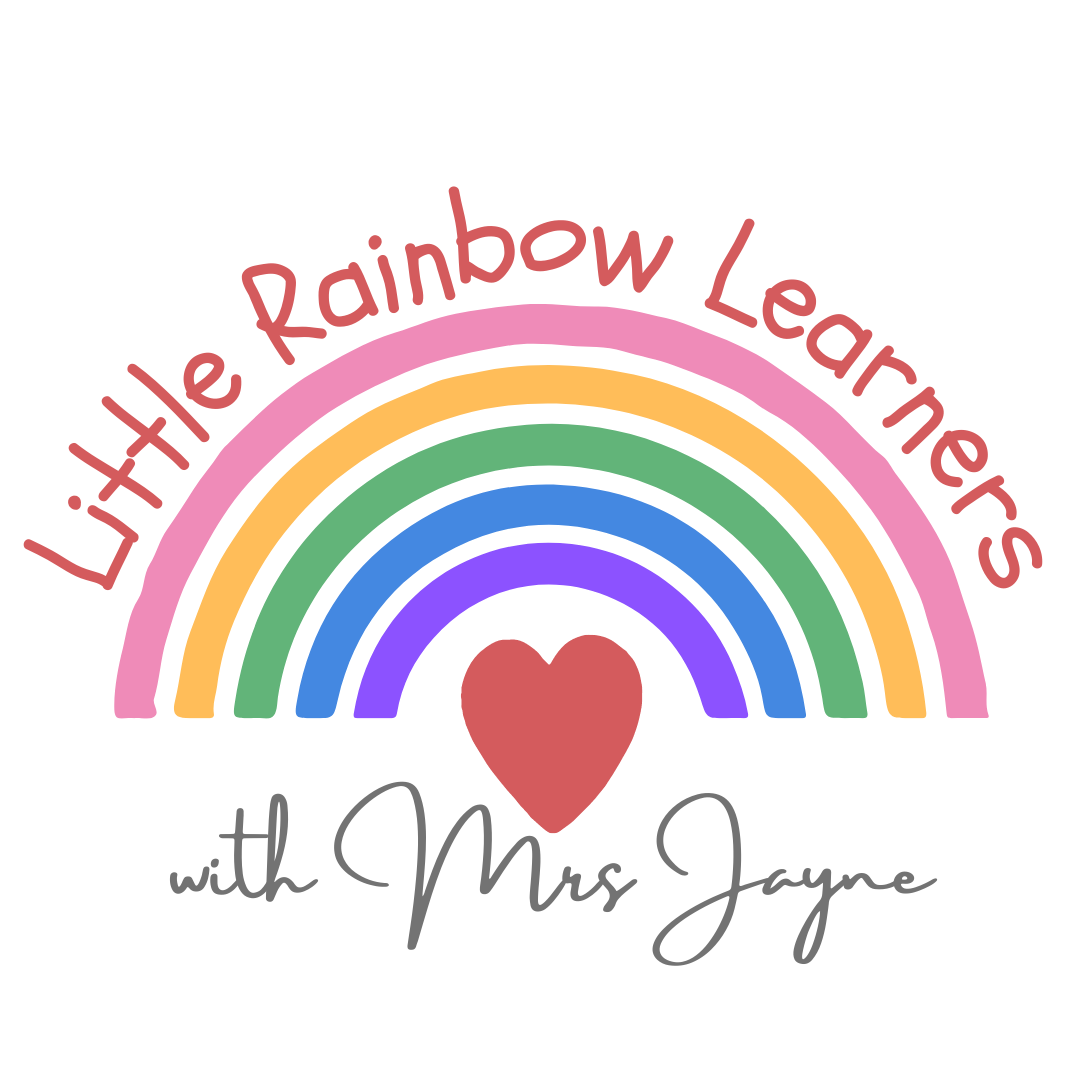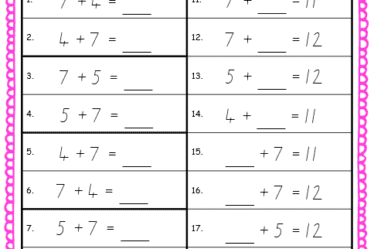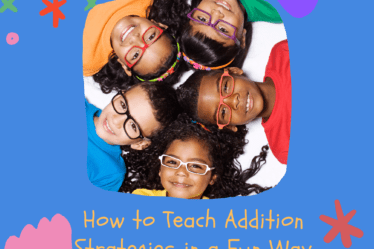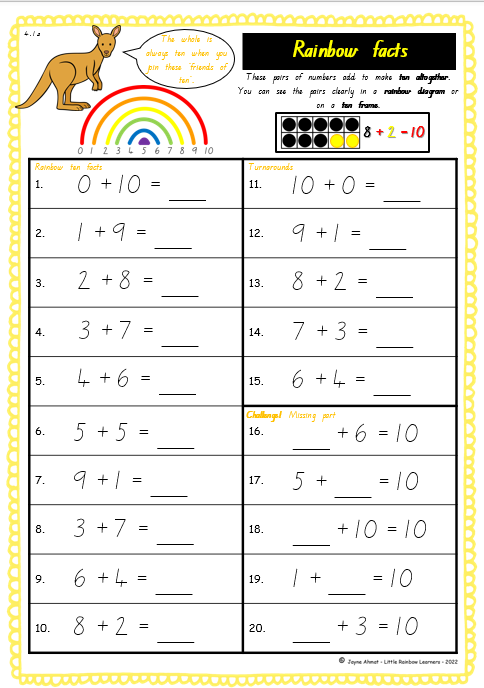
Hi-dee-ho Early Years Teaching Superstars!
Are you wondering if teaching addition strategies in Year One is a thing? Are you interested in learning more about how to teach addition without using fingers?
Well, stick with me – I’ve got you covered!
Like most other Early Years educators, I’m a planner – an organiser – a creator of systems and structure! So when I’m considering how to teach addition facts to little learners, I create a clear plan at the start of each term. By doing this, I have always been able to lead my little rainbow learners through all of the content prescribed by the curriculum, plus garnish with some cherry-on-top elements often skimmed over by other planning providers (case in point – addition strategies!) … & still have time left over for fun, games, yoga & art!
Let me show you how …

How to teach addition Year 1
You’re wondering … how to start teaching addition?
My response … hands-on exploration, explicit teaching of strategies & regular practice.
Early years maths programs celebrate multimodal learning! As teachers, we provide our budding mathematicians with many opportunities to manipulate counting resources, experiment with ten frames and counters, explore MAB blocks and connecting cubes, and play with number lines. We are experts at offering card games, dice games, board games, songs, stories and craft experiences, along with engaging worksheets to practice prioritised skills. We engage children in these learning experiences as a whole class, in small groups and as independent learners. All of these are essential elements in our maths programs, including teaching addition strategies.
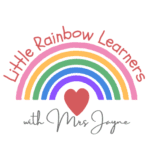
You’re wondering … how to fit the addition strategies into your planning?
My response … in bite-sized chucks – one per week – starting from mid term 1.
When it comes to teaching addition strategies to Year 1 children, I recommend planning to cover the first 6 of the 10 basic addition mental calculation strategies in term 1.
Addition strategies Year 1:
- Turnarounds
- Add zero
- Count on
- Rainbow facts
- Add ten
- Doubles
The final 4 strategies, which are not essential for Year One learning, are:
- Near doubles
- Near ten, add nine
- Near ten, add eight
- Bridging ten to teach ‘the leftover’ facts
Assuming it’s an average-10-weeks-long term, I would keep the first 4 weeks of the year for settling in, establishing the 3R’s (Relationships, Routines & Rules) & just focussing on the content set out by
a) your state’s system
or
b) your school.
I’ve almost always worked in smaller schools that implement the National Curriculum via the state’s system as a skeleton structure for presenting content:
- ‘C2C’ Curriculum documents in Queensland State Schools;
- and ‘Diocesan Learning Framework’ documents in Queensland Catholic Schools.
I also have experience teaching in larger schools where H.O.C.’s (‘Head of Curriculum’ Teachers) use the National Curriculum to create their own school-based system as the skeleton structure for content delivery. Teachers are provided with H.O.C.-created planning documents for each term. Here, I’ll call both of these planning systems “provided curriculum”.
In either case, I start the year by glancing over the content stipulated for term 1 in the “provided curriculum” & dropping it into a simple Word Doc table. I then insert the first 6 mental addition strategies by placing 1 strategy in each week of my maths planning from weeks 5 to 10. I then look for double-ups – are any of these first 6 strategies also stipulated in the provided curriculum (whether state or school based)? If so, I move the topics in the provided curriculum to match up with the same week I plan to teach a strategy.
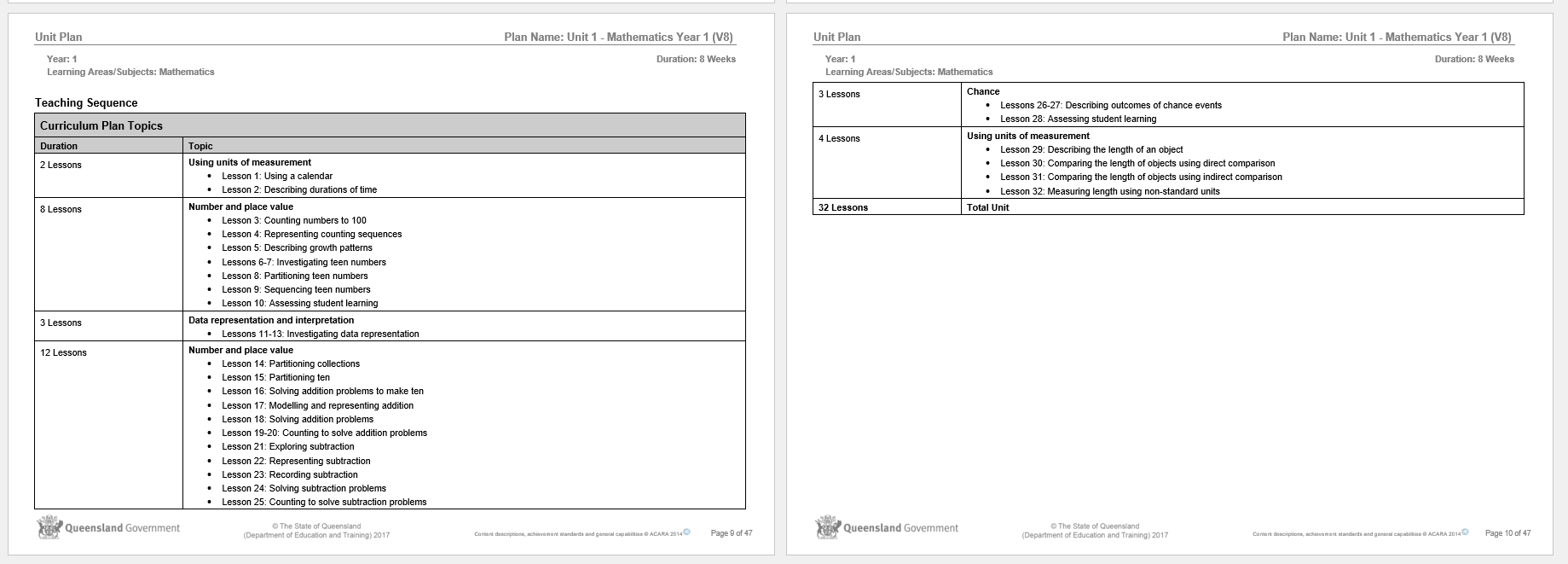
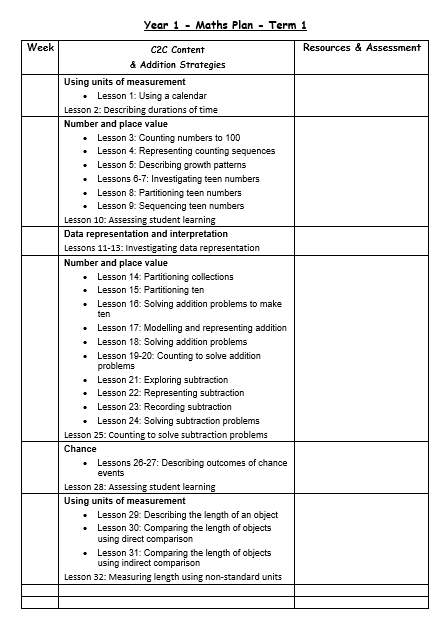
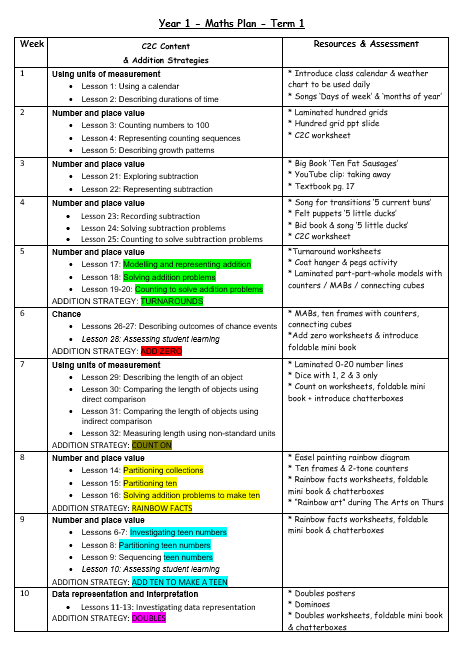
Left – drop the ‘provided curriculum’ into a simple table in a Word document.
Right – adjust the order of content to suit the introduction of each of the six addition strategies.
You’re wondering … how to teach addition strategies?
My response … sequentially and explicitly.
It’s important to teach the addition strategies in this set order, as they progress from easiest & most commonly used to hardest & less frequently needed. Also, many of the later strategies build on knowledge of earlier strategies. So, I find moving around topics in the provided curriculum is preferable to mixing up the order of the addition strategies.
I start each week by presenting a new addition strategy, backed up with lots of hands-on experiences: joining groups of objects, moving counters on ten frames, jumping along a laminated number line with a whiteboard pen, exploring with MAB blocks & manipulating connecting cubes.
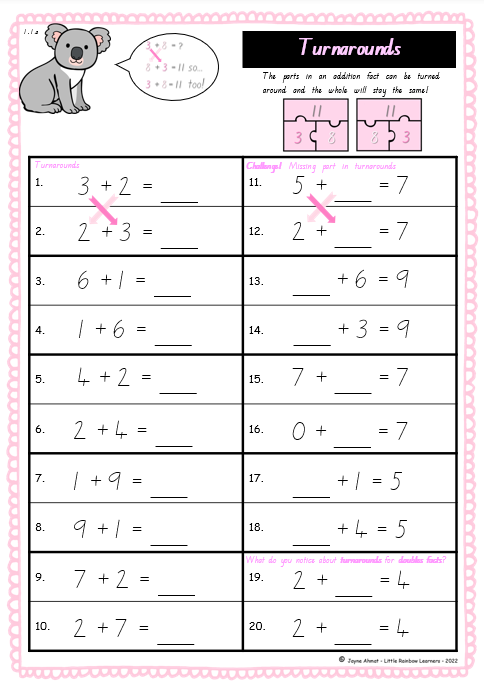
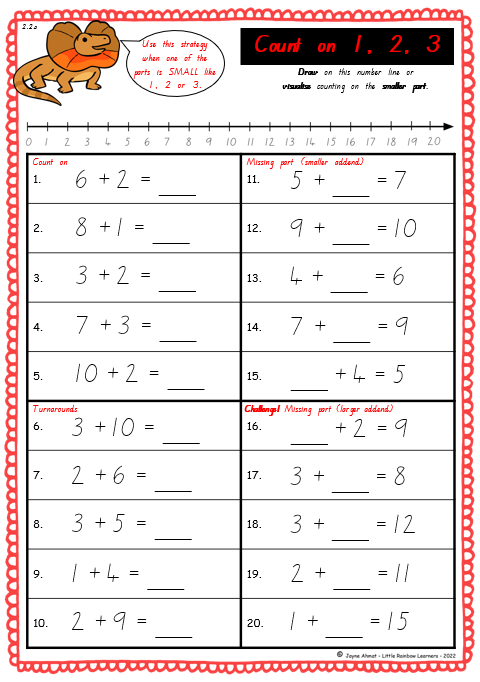
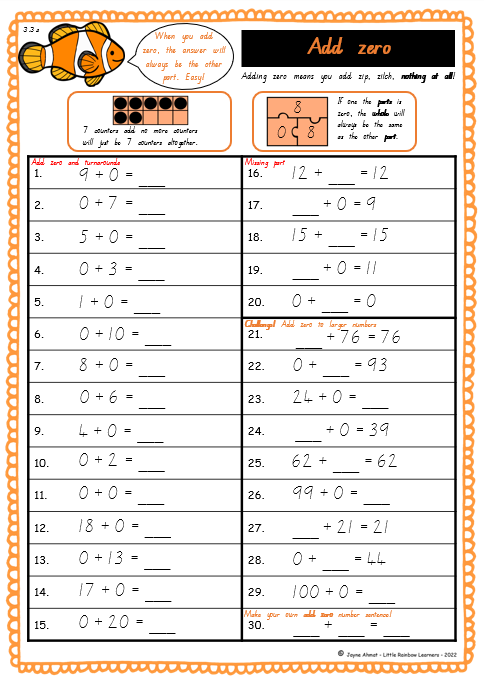
Term 1
I make the first half hour of our maths block on Monday an explicit lesson to introduce the ‘addition strategy of the week’. I start with an “I do” lesson where I model the strategy on the whiteboard or interactive screen with physical resources (like connecting cubes, MAB blocks, ten-frames, counters & number lines) plus drawings & diagrams. I make the steps & the language of the strategy explicit by ‘thinking out loud’ as I work through addition number sentences. I model how to use the hands-on resources as well as how to visualise the resources so I’m calculating mentally.
I then move into a “we do” phase by asking learners to contribute answers, ideas & thinking as we work through more examples together. This involves children answering questions orally, coming out to type in missing numbers displayed on the interactive screen, drawing diagrams on the whiteboard or sharing their ‘think out loud’ explanations of the steps involved in the strategy.
I wrap up this first lesson with a short time to enjoy a “You do” task – most often a worksheet. This is particularly important at the start of the year, as it gives me a chance to train the children in completing the worksheet independently. I dedicate the remainder of the maths session on Monday to whatever other concept is the focus of the provided curriculum.
I always run maths groups during the week, on any 3 days from Tuesday to Friday that fit into busy class & school timetabling. I like to have students arranged into 3 ability-based groups & do one 30 min session on each of the 3 days with no rotations. In reality, this 30 min session ends up being:
- 5 mins to explain the week’s activities / resources & for children to gather their group’s maths box & find a space in the room to work together;
- 20 mins for working in their small work on their allocated task;
- 5 mins to tidy up at the end.
I often have a teacher aide or parent volunteer supporting 1 group, at least 1 group will be working independently & 1 group will be working with me.
I dedicate 1 of the maths group activities to practising the strategy of the week.The other 2 groups will generally be working on whatever maths concept is stipulated by the provided planning that week. At the start of the year, the group practising the addition strategy of the week will need to work with me for the first few weeks until I’ve established strong routines around:
*independently accessing hands-on resources from the maths shelves (“Help yourself to whatever you need – a number line? Some counters & 2 ten-frames? MAB blocks?”),
*who to ask for help (the person you’re sitting next to / an ‘expert’ – that’s the child in the group who has a strength in this area / the aide or parent helper),
*what to do if you are still stuck on some questions (leave them blank for now, complete as much of the other work as you can, come back to the tricky ones at the end if you have time, let the teacher know which ones were really tricking you when it’s pack up time),
*where to put completed work (glue it in your scrapbook / place it in your bag to take home / drop it in a tray for marking),
*what to do if you don’t get your work finished (it’s ok to leave some blank – as long as you’ve been putting in an honest effort for the whole 20 mins),
* what to do if you’re a fast finisher (I always have a shelf of maths games & a box of leftover maths worksheets for kids to choose from).
As the term progresses, I move the activity for the addition strategy of the week to the ‘parent helper / teacher aid’ group for a week or two, & then ultimately, to the ‘independent group’. In this way, students are always presented with a whole-class explicit lesson on the strategy, they then practise the strategy in whole-class & small group settings with a gradual reduction in support as their confidence & independence grows. The last maths lesson of the week involves a review of the strategy of the week. This might be a written ‘pop quiz’, a whole class oral question & answer game, flash cards, a game with a partner or completing unfinished worksheets & may take anywhere from 10 to 30mins depending on several factors, including:
- the competency of the class with the target addition strategy,
- the number of interruptions our maths lessons suffered during the week,
- how much of the week’s work we completed vs how much we left to catch-up on on Friday,
- the need for reteaching / revision / consolidation / extension.

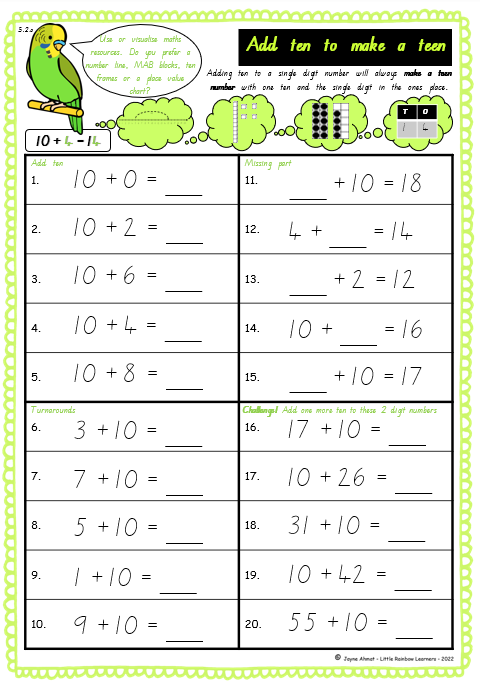
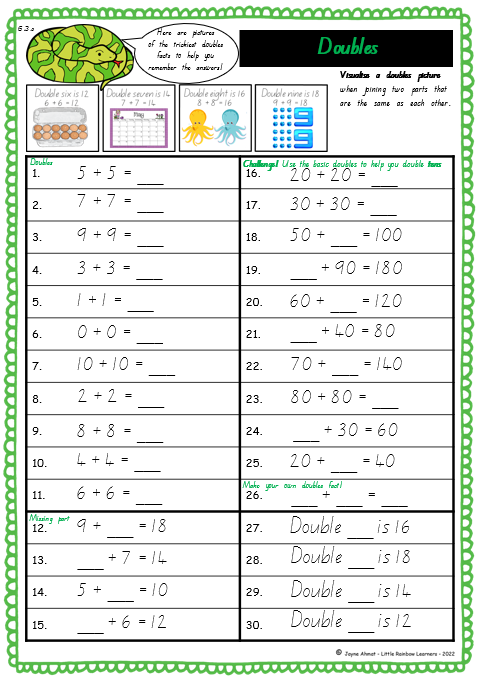
Term 2
In term 2, I follow the same general procedure for setting out my term plan by combining the provided curriculum with weekly attention on each of the first 6 strategies. I cover the 6 strategies in the first 6 weeks of the term (give or take a week), in the same order as term 1 … but this time, with a focus on reversing the strategy so it becomes a subtraction strategy.
The revision of each addition strategy solidifies concepts covered in term 1, while flipping each strategy to be used as a subtraction strategy extends little learner’s thinking into fact families & the connectedness between addition & subtraction. In this way, subtraction is not a novel concept to learn, or a new list of facts to memorise, but is merely a natural extension, unfolding & adaptation of the addition strategies already established.
So …
- the “turnaround” addition strategy becomes playing with part-part-whole models to create pairs of subtraction facts & fact families with 2 subtraction facts & 2 addition facts.
- the “count on 1, 2 or 3” strategy for adding a small part becomes count back 1, 2 or 3.
- the “add zero” strategy allows exploration of ‘taking away zero means subtracting nothing, the whole remains the same’.
- the “rainbow facts” addition strategy lends itself beautifully to exploring number combinations that the whole ‘10’ can be partitioned into.
- the “add 10 to make a teen” strategy is explored as taking 10 from a teen number to leave a single digit part, or taking the single digit part to leave 10. Lots of investigation into tens-&-ones place value, ten more / ten less & 2 digit numbers springs from here.
- and the “doubles” addition strategy is flipped to create awareness of halves subtraction concepts – “if you know the doubles, you know the halves as well”!
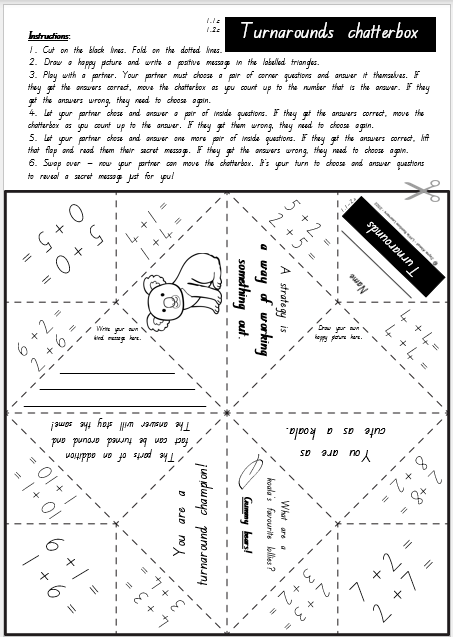
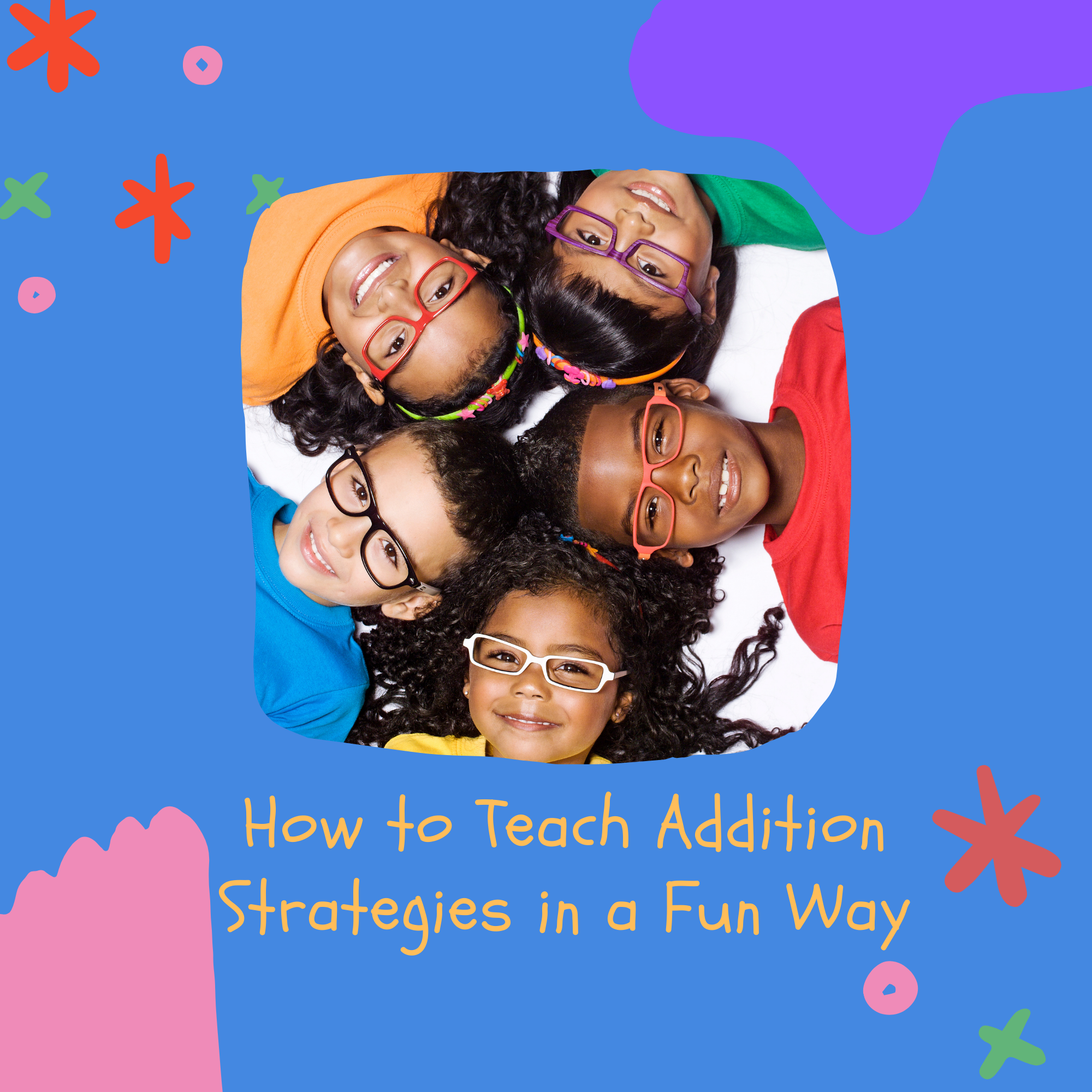
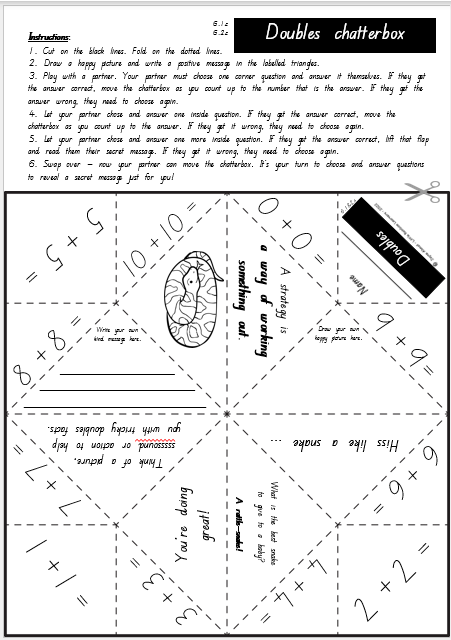
Terms 3 & 4
I use the second half of the year to continue practising, revising & applying these first 6 strategies as methods of mental calculation for both addition and subtraction, all the while moving gradually away from reliance on hands-on materials into the zone of visualisation, mental computation & eventual recall of basic facts.
Games, hands-on resources, fact family worksheets, chatterboxes, foldable mini books provide lots of time for revision & repetition for the little learners who need to continue practising the 6 basic addition strategies in small groups.
For rainbow learners ready for more challenge, the basic addition strategies can be extended . For example:
- doubles addition can be expanded into the 7th basic addition strategy of near doubles / doubles plus one (5 + 6 is just one more than 5 + 5. I know 5 + 5 = 10, 1 more than 10 is 11);
- and the basic doubling of ones leads to the fancy-pants trick of doubling tens (4 + 4 = 8, so 40 + 40 = 80);
- rainbow ten facts can be explored as ‘rainbow hundreds’ (if 3 + 7 = 10, then 3 tens (30) + 7 tens (70) = 10 tens (100)) AND as ‘rainbow twenty’ facts (is 3 + 7 = 10, then 3 + 17 = 20);
- counting on doesn’t just work well for adding a small part (1, 2 or 3) to another part that will create a whole of up to 20. You can count on 1, 2 or 3 even when the other part is a 2- or even 3-digit number! Now, 76 + 2 or 3 + 124 become manageable to manipulate mentally!
- Counting on 1, 2 or 3 ones can be applied to counting on 1, 2 or 3 tens too! You can easily start at 56 & count on 2, so have a go at starting at 56 & count on 2 tens: 56 … 66, 76. Hundreds grids help children counting on in tens.
Terms 3 & 4 are also perfect for applying the basic strategies to everyday situations…
We have 23 friends on the roll, but 2 are away. How many friends are here today? How did you work that out? That’s right, 2 is a small number, so counting back is a great mental strategy to use! Start at 23, visualise a number line in your head & count back 2. 23 … 22, 21.
and word problems …
Kate has 10 friends coming to her party. She has already made 4 party bags. How many more does she need to get ready? How did you know it was 6? Yes, because 4 & 6 always make 10 – they are pairs in the rainbow diagram.
Nearly all little learners find subtraction more difficult than addition. So the second half of the year allows more time to continue engaging with subtraction concepts, build fact families & use what we know about addition to help us solve subtraction problems. Lots of work with part-part-whole models & hands-on resources will support their learning.
I hope you have found lots of useful suggestions here! Have fun with your little rainbow learners.
Celebrating the diversity of the little learners in your classroom.
Related Articles:
Read an informative research paper about the importance of developing mental strategies rather than relying on counting to solve addition, published by Australia’s Monash University, here: The Development of Addition and Subtractions Strategies for Children in Kindergarten to Grade 6: Insights and Implications
Check out Lucky Little Learners’ strategy-based-approach to addition here: 14 Strategies for Teaching Addition
Read Teaching Trove’s take on developing early learner’s number fact fluency here: Addition Strategies to Increase Fact Fluency
Need a set of addition strategy posters to display in your classroom?
I’ve got you! Click here to preview my set of Australian animal / rainbow themed addition strategy posters in my Teachers Pay Teachers store ‘Little Rainbow Learners’!
